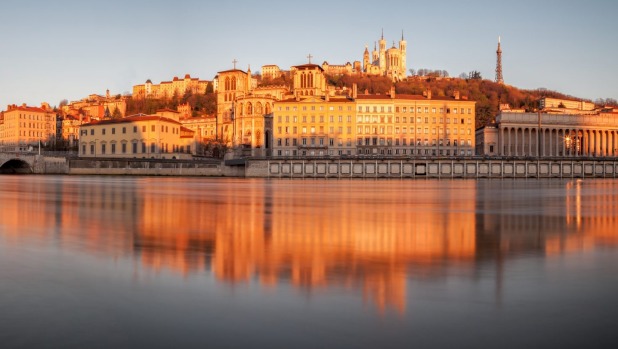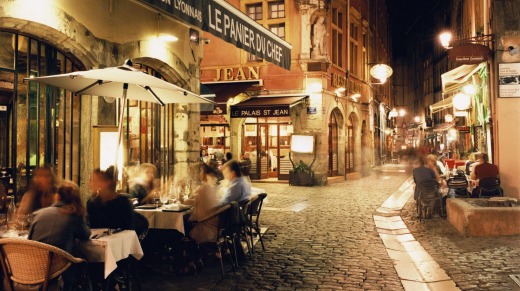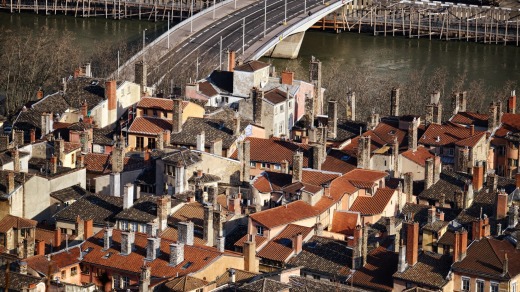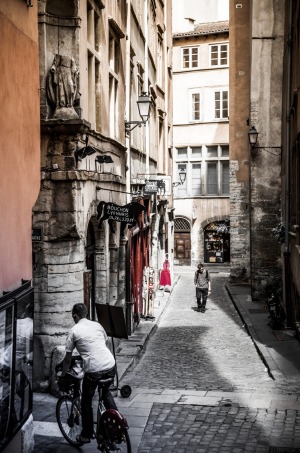
A white-gold winter sun sets behind Fourviere hill above the river Saone, warming the city of Lyon with its last rays. I take a coffee at an unpretentious riverside cafe, Bouvette de Napoleon.
The air is very still, crisp though not too cold, and a scatter of brassy leaves still clings to the trees along the riverside. A blues track grinds out from the cafe stereo, blending with the music of spoken French rising from the tables around me. I'm less than two hours from Paris by high-speed TGV, but it feels a long way away. Not another country, but another mood.
The roofs of the riverside apartments here are terracotta-tiled and the stucco is ochre, rust and persimmon: the colours of Venice. If there's a French city with a worse case of Italophilia, I'm yet to find it.

Lyon was founded in 43BC, a year after the assassination of Julius Caesar, up on the Fourviere hill at the juncture of the Saone and Rhone rivers. The city rose to become one of Rome's most redoubtable border settlements, and among its remains are two well preserved amphitheatres and a hillside honeycombed with 1st-century masonry.
Lyon has certainly got a wriggle on since then. Today it's a thriving commercial, university and gastronomic town with an earthy food culture rooted in a warren of home-style eateries named bouchons.
Lyon's gastronomic scene is aided by being close to the vineyards of Beaujolais and the Rhone, contrasting the light and fruity gamay of the former with the latter's heady shiraz. There's plenty of refinement, too. Paul Bocuse is the leading, though not the only, light of the high-end food scene; and the wines of the Cote-Rotie (or "roasted slope") are up there with the best the country has to offer.

My visit begins with a tootle around the Fourviere hill, crowned by the church of Notre-Dame de Fourviere. The church was built in the late 19th century and riffs on the Byzantine idea of spiritual bling: the interior, with not a painting in sight, is covered in lavish gilded mosaics. It's a weird Romanesque-Byzantine-Gothic hybrid – postmodern before the word existed – but there's no doubting its prominence on the skyline of Fourviere hill.
A short walk away, still on the crest of the hill, you find the modernist concrete museum of Gallic-Roman history. Its greatest jewel is probably a Roman sarcophagus carved in crowded high-relief depicting the Triumph of Bacchus returning from Asia, with cameos by Ariadne and Pan. The theme would become a favourite of late Renaissance artists, Titian and Velasquez in particular.
Every hole sunk into the ground of old Lyon seems to yield some kind of Roman artefact; an entire suit of armour, replete with chain mail and weaponry, was found when some chap decided to built a garage. Museum curators must rub their hands with glee whenever a new building project gets the nod.

My first hour atop the Fouviere hill is shrouded in mist. When it lifts, a sky of cold hard blue spreads out behind it. Winding my way down the hill along a path bordered with wintering plane trees, I come to Lyon's most distinctive district, a quarter of cobbled streets, slender spiralling towers and arcaded courtyards pressed tightly between the foot of the hill and the banks of the Saone. It's like a setting for Rome and Juliet, Othello, Much Ado About Nothing, or any other of Shakespeare's Italian plays.
The buildings mushroomed upwards when this part of Lyon rose to prominence on the back of the 16th-century silk trade. There was a push in the post-war years to level the cluster of lovely twisting towers so evocative of the renaissance, and the slumbering courtyards in which they stand. It is Lyon's great good fortune that sanity – and the intervention of Socialist minister Andre Malraux – prevailed. For Vieux Lyon alone is reason enough to visit the city.
"You know in Vieux Lyon we have the biggest Renaissance district outside of Venice," a local tells me over lunch at Daniel & Denise, one of the more refined of Lyonnais bouchons.
It's a big call, and one not likely to go unchallenged in Florence and Bruges. The old quarter of Lyon is certainly the largest Gothic and Renaissance precinct in France. Coincidentally, an exhibition on the humanist Renaissance in Lyon – a golden age of painting, architecture and publishing during the 16th century – is running at the local Musee des Beaux-Arts when I visit.
The next day I return to the old quarter to visit the owner of Antic Wine, Georges dos Santos, for a tasting of the region's finest. There's a forest of open bottles on a bench, while others are being uncorked with that sweet squishy pop as I wait.
When Georges arrives, he invites me to contrast a Chablis from burgundy with a white Rhone blend of Marsanne and Rousanne: if the former is a violin; the latter is a saxophone.
Suddenly and for no discernable reason – perhaps because he loves shiraz and I come from a land of shiraz – George decides I need an education in the ways of old Lyon.
"Come," he says, twirling a hand as he dashes out his cellar and into the street with a glass of white in one hand and a bottle in the other.
Georges has a favourite bouchon, les Adrets, and he bursts into the place as the staff are whizzing around setting tables for lunch.
"Look," he commands, and I follow his gaze towards a low ceiling of heavy wooden beams. "It was once a stable."
He presses forward, past the bemused wait staff into the kitchen, where I meet the chef, Jean-Luc Wesolowski. George offers him a glass of white from the bottle in his hand.
Wesolowski shakes his head politely and points to a bench. He already has a glass of something – and it's red. He offers me a taste of beef stew, ladling it out with a wooden spoon. Simmering away in a big pot are two enormous andouillettes – the most challenging of all French culinary enthusiasms – the size of small limbs.
"You have to book far in advance to get into Les Adrets," George says as we leave. "Maybe months."
Returning back along Rue de Boeuf (Beef) – with the scents from Wesolowski's kitchen still fresh, I can't think of a more appropriate name – he presses on. Soon we come to a courtyard framing a rose-red Renaissance tower called, aptly enough, la Tour Rouge.
Further on we burst into an interesting variation on the same theme. La Cour de Loges, a five-star hotel, is a courtyard wrapped around a restaurant: the seats are in the open section, the kitchen secreted away behind a set of screens. To one side, beneath a stone vault, I catch a glimpse of a bar with a frescoed wall.
Old Lyon is heavily touristed – the number of Irish pubs is testimony to that – and yet it retains the secretive, slightly disorienting air of a labyrinth. Most of the old streets run parallel to the river, and in order to move quickly down to its banks for water – and for transport – the old quarter was built with an elaborate fretwork of "traboules". These are passageways allowing public access through private dwellings between one street and the next.
The passageways, courtyards and towers are part of the same urban ensemble; and they are unique to Lyon.
As George goes crashing through one door after another – we visit a photographer specialising in scenes of the old quarter, then a silk shop keeping alive the old craft – I wonder if he isn't the worst possible neighbour. But he's welcomed warmly everywhere he goes.
The denizens of this part of town, it turns out, operate on a kind of tacit agreement: that closed doors are open to those who know the ways of Vieux Lyon. In the morning hours, many of the traboules permit public access. Of course, it helps to have a local guide to find them.
Lyon is culturally rich and commercially vibrant. It does a lot of looking back. But it never stands still. The contemporary Jean Nouvel-designed opera house, a glass and steel barrel vault atop an original 1830s base of neo-classical inspiration, is the perfect emblem for a city that seeks to honour both the innovative and the antiquarian.
And yet it's easy – all too easy – to let days roll by in a gastronomic procession. One morning, I set out for the old Croix-Rousse silk-weaving district on the opposing hill from the churchy Fourvier, across the river Saone. Runs an old Lyon saying: "On one hill they pray; on the other they work."
But I give the area a once over lightly after discovering a seafood market attached to a bar where I can sit with a plate of 12 fresh oysters and a glass of chablis and watch the pre-Christmas pageant of eating and shopping – very little praying – pass by.
On another visit to the crest of the Fourviere hill I wander through the old Roman amphitheatres wondering about what, exactly, was performed there – a bit of a poetry reading followed by something more gladiatorial, perhaps? But I'm promptly drawn back to the here and now when, from a table at nearby Tetedoie restaurant, I survey the city below and the large plain fanning out to the east.
The restaurant is entirely modern and the business lunch is great value. The highlight of my meal is a fillet of duck with orange and pumpkin, matched with a glass of velvety cornas: an earthy and elegant shiraz. But the view of Lyon beneath a silvery winter light is undoubtedly the star.
On my last night in town I sit down for a solo meal at a seafood restaurant with a belle Epoque interior, Chez Moss, in the heart of the Presqu'Ile between the two rivers. The place is booked out, but I manage to squeeze myself in by turning up early for a snappy one-course meal – a skewer of six fat scallops on a bed of rice and vegetables, accompanied by a glass of chablis.
Seated next to me is a couple in their late middle age. The waitress welcomes them with a flourish of kisses, the sommelier too. Anyone would think they are family. And in a uniquely Lyonnais sense, they are.
This is the city that invented the bouchon. The best of the chefs in these local institutions – such as Joseph Viola of Daniel & Denise – serve up an elaboration on tradition and the cuisine of the home. And to dine there you are, at least in spirit, among friends.
"Lyon is really a small town," the waitress at Chez Moss explains, as I pay. "You never get lost here. But I'm a local girl," she shrugs. "I'm biased."
We talk about the city's charms.
"It looks Italian, do you think?" she asks. "I was in Florence a few weeks ago. Wonderful. And Lyon is just like that. By the river with hills" – she waves her hand, gazing at an imaginary panorama – "all around."
When I return to my room – my last night in town – I reach into my bag and discover a crusty, dusty saucisson. A great mound of them had been sitting in a basket at George's bar a vin; he has evidently dropped it in, slyly, as a Christmas present. It will do just fine for a lunch on the train to the cold north, touched by the warmth of Lyon in winter.
onlylyon.com/en/
Singapore Airlines offers flights from Perth, Melbourne, Adelaide and Sydney to Paris on its A-380 service from Singapore to Paris Charles de Gaulle. Lyon is less than two hours away by TGV.
The 80-room Hotel Carlton is centrally located on the Presqu'Ile between the two rivers, five minutes' walk from the Bellecour metro stop and 10 minutes by taxi from Lyon-Part-Dieu train station. The hotel retains many of its original Belle-Epoque features and a 2013 renovation has also equipped it with a sauna and wellness centre. Doubles rooms from $233.
Lyon's Musee des Beaux Arts on the Presqu'Ile and its Gallo-Roman Museum on Fourviere Hill together provide a comprehensive survey of the city's history and art traditions while offering, at the same time, objects of European, if not world significance. The contemporary Musee des Confluences, also on the Presqu'Ile, is a natural science and anthropology museum focused on journeys through space and time.
Chef Joseph Viola has three restaurants in Lyon under the Daniel & Denise brand, and the charming Saint-Jean bouchon offers a Menu Lyonnais with four traditional courses, including saucisson brioche, for $62. . A $33 main course plus dessert menu is also available between Tuesday and Friday. danieletdenise.fr/restaurant-daniel-denise-saint-jean-la-carte/
Christian Tetedoie's one-Michelin star restaurant on Fourviere hill not only boasts a splendid view of the city, it offers a refined lunchtime meal of entree, main course and desert with a glass of wine, a half-bottle of water and coffee for $80.tetedoie.com/intro.html. The bar, with an outdoor section in summer, offers the same panoramic view.